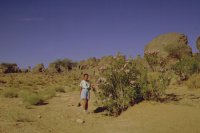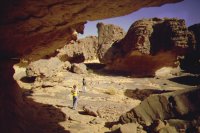

|
Approaching from the east, the path crosses over uninspiring country (by Tassili standards), until abruptly descending into a small wadi with , with a smaller 'towngrid' terrain on the other side. This is the Sefar wadi, and the streets beyond contain the world's largest prehistoric art gallery. The trek from Tamrit to Sefar will take about four hours, covering about 15 kms. The approved campground is the first 'street' on the left. It takes the best part of a full day to visit all the major paintings, and several days are probably needed to see all. For convenience, the site can be split in half along the line of the 'camp street'. |
|
The highlights of the southern part are the costumed dancing figures and the tiny gazelles just beyond the campground, the 'homestead' scene from the bovidian period, 'the masked lady', and the three masks. |
|
The larger northern part contains a very large scene from the roundhead period with a large bovid (bubalus ?) and typical roundhead figures adoring a 'great god', and the most famous scene of them all, 'The Great God of Sefar', which happily is in a reasonably good shape, despite some blundered preservation attempts. There are hundreds of others in shelters along the sides of the 'streets'. |
|
Unfortunately many of the better known paintings are very faint and some have gone altogether, due to wetting during copying by the Lhote mission, and by subsequent visitors, but there is still an enormous amount left to enjoy. |
 |
 |
 |